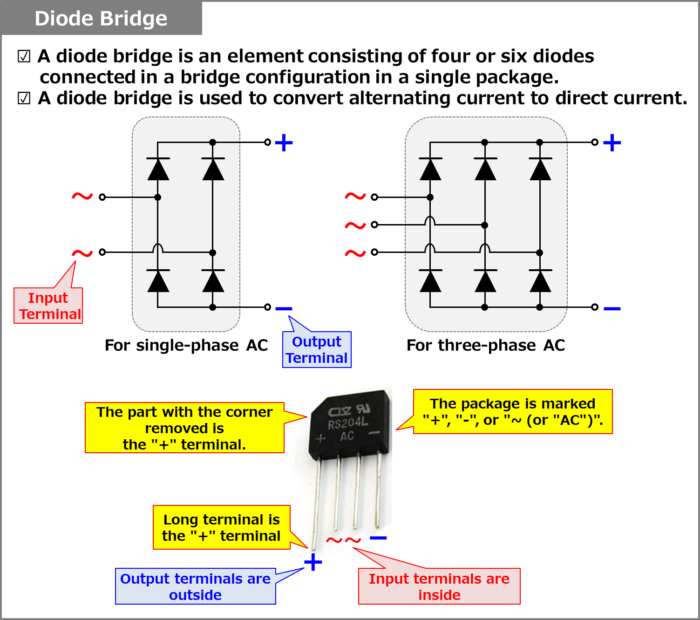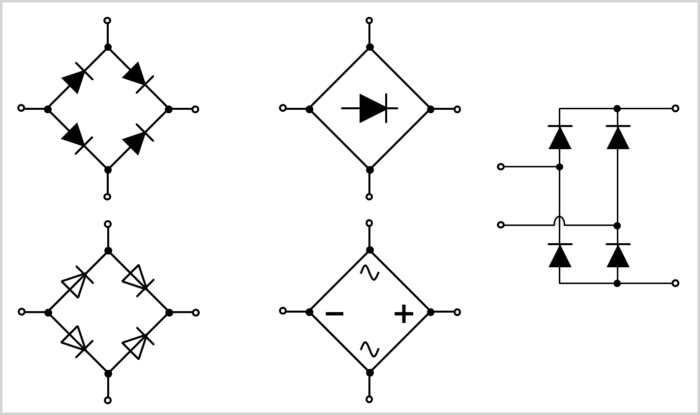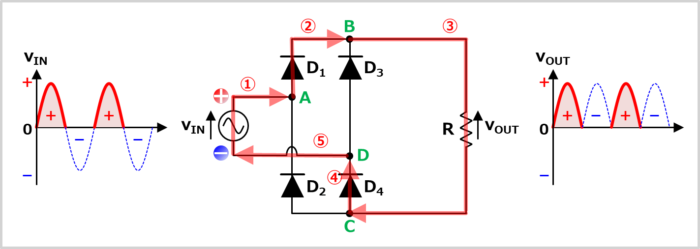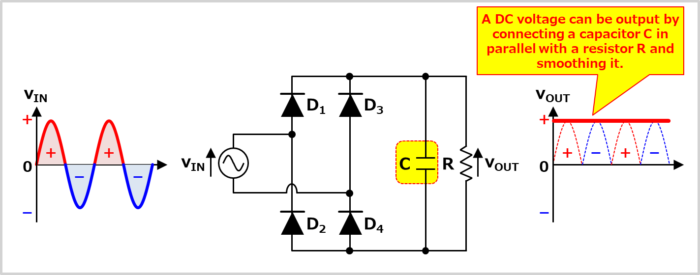Regarding the "Diode Bridge", this article will explain the information below.
- What is a Diode Bridge?
- Symbol and Working of Diode Bridge
What is a Diode Bridge?

A diode bridge is an element consisting of four or six diodes connected in a bridge configuration in a single package.
A diode bridge is used to convert alternating current to direct current.
The reason why it is called a diode bridge is that the shape of the diodes connected to each other looks like a "bridge".
A diode bridge is marked with "+", "-", and "~ (or "AC")" on the package, so it is easy to distinguish where to connect them as shown below.
- Where "+" or "-" is indicated
- The "+" and "-" are output terminals and are connected to the output section.
- The "+" and "-" are marked on the outside of the package.
- Note that the output terminals have "+" and "-" polarity.
- Where "~ (or "AC")" is indicated
- The "~ (or "AC")" is an input terminal and is connected to the AC section.
- The "~ (or "AC")" is indicated on the inside of the package.
Supplement
- The top of some diode bridge packages has a corner removed. In this case, the angled part is the "+" terminal.
- A diode bridge may have one long terminal. In this case, the long terminal is the "+" terminal.
Symbol of Diode Bridge

A diode bridge has various circuit symbols.
The above figure shows a summary of circuit symbols found on the Internet and in patents. The top left circuit symbol is the most common.
Working on Diode Bridge

A diode has the characteristic of conducting when the potential of its anode (A) is higher than the potential of its cathode (K).
If you understand this characteristic, you will understand the "working" of a diode bridge.
Now, I will explain the "working" of converting alternating current to direct current with a diode bridge separately when the alternating voltage is "+ (positive)" and "- (negative)".
When AC voltage is "+ (positive)"

- When the AC voltage is "+ (positive)", the current initially flows at point A.
- Diode \(D_1\) conducts because the potential of the anode (A) of diode \(D_1\) is higher. Diode \(D_2\) does not conduct because the potential of the cathode (K) is higher. Therefore, current flows through diode \(D_1\) to point B.
- At point B, diode \(D_3\) does not conduct because the potential of the cathode (K) is higher. Therefore, current flows through the resistor \(R\) to point C.
- At point C, the potential of the anodes (A) of diodes \(D_2\) and \(D_4\) is higher, but comparing the voltages at points A and D, the voltage at point D is lower, so the current flows through diode \(D_4\) to point D.
- The current flowing at point D returns to the AC voltage \(v_{IN}\).
When AC voltage is "- (negative)"

- When the AC voltage is "- (negative)", the current initially flows at point D.
- Diode \(D_3\) conducts because the potential of the anode (A) of diode \(D_3\) is higher. Diode \(D_4\) does not conduct because the potential of the cathode (K) is higher. Therefore, current flows through diode \(D_3\) to point B.
- At point B, diode \(D_1\) does not conduct because the potential of the cathode (K) is higher. Therefore, current flows through the resistor \(R\) to point C.
- At point C, the potential of the anodes (A) of diodes \(D_2\) and \(D_4\) is higher, but comparing the voltages at points A and D, the voltage at point A is lower, so the current flows through diode \(D_2\) to point A.
- The current flowing at point A returns to the AC voltage \(v_{IN}\).
Supplement

- A DC voltage can be output by connecting a capacitor \(C\) in parallel with a resistor \(R\) and smoothing it.
Type of Diode Used in Diode Bridge
Many diode bridges are made for applications that rectify 50/60 Hz AC voltage supplied from an outlet. In this application, the type of diode used in a diode bridge is often a "general rectifier diode".
Diode bridges may also be used in places where the frequency is high, such as the secondary side of switching power supplies. In this application, the type of diode used in a diode bridge is "fast recovery diode" or "schottky barrier diode (SBD)", which is suitable for fast operation.
Summary
In this article, the following information on the "Diode Bridge" was explained.
- What is a Diode Bridge?
- Symbol and Working of Diode Bridge
Thank you for reading.